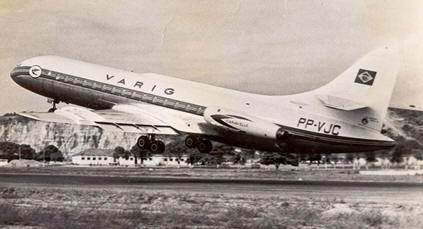|
AIRCRAFT |
|||||
|
|
Always thinking about innovation
and comfort for its passengers, VARIG was the first Brazilian
company to order jet aircraft in 1957, the Boeing 707 and Caravelle.
Sud-Aviation made a demonstration flight of the Caravelle on April
24, 1957, in Porto Alegre for VARIG. The aircraft positively
impressed Ruben Berta, director Rudy Schaly and four company pilots.
VARIG was the third airline in the world to order Caravelle, after
only Air France and SAS.
VARIG's first Caravelle I, PP-VJC, was ready on August 31, 1959 and
was officially delivered to the company on September 22. The
aircraft arrived in Porto Alegre on the 24th, where employees were
able to enjoy the new aircraft. The Caravelle experimental flights
during September and only started regular service on October.
The original plan was to use Boeing 707 for the international route
to New York and Caravelle for the main domestic routes. However,
Boeing was dealing with a large number of orders for Boeing
707 and Caravelle arrived earlier. Caravelle was then prepared to
operate VARIG's main route, connecting Rio de Janeiro to New York.
The aircraft was set with only 40 seats, in 10 rows 2 to 2. The
first flight took off on October 2, 1959, on Porto Alegre - São
Paulo (Congonhas) - Rio de Janeiro - Belém - Port of Spain - Nassau
- New York route. The flight time was reduced from 25 to 14 hours
after Caravelle introduction. VARIG was the first airline to operate
a pure jet at Idlewild Airport, now called John F. Kennedy, in New
York.
On December 12, 1959, the second Caravelle, PP-VJD, began operating
on the route to New York as well. The Caravelles then began to share
Rio - New York route with Lockheed Super G Constellation. Caravelles
flew twice a week and Super G Constellation also twice a week,
totalizing 4 weekly frequencies. Caravelle I use to had a parachute
to help it slow down during the landing, which is common in military
aircraft, but it was a problem to collect it at airports.
Subsequently, reversible turbines were installed, which replaced the
parachute.
In 1960, with the arrival of B707, the Caravelles moved to South
America routes and domestic flights. The aircraft were then
reconfigured with 52 seats, then with 68 seats and finally with 73
seats. The main routes operated by these aircraft were between Rio
de Janeiro, Porto Alegre, São Paulo, Campinas, Brasília and Belém.
Caravelle also operated on routes to Montevideo, Buenos Aires, Lima,
Bogota, Santo Domingo and Miami.
On September 27, 1961, the PP-VJD suffered an accident in Brasilia
during the landing. No passengers or crew were injured, but the
aircraft suffered total loss. To replace it, VARIG acquired a new
unit in December 1961, previously operated by Air Algerie, and named
in Brazil as PP-VJI.
Despite having great success among passengers, Caravelle was not
ideal for the Brazilian market at that time and ended up being
retired in 1964, after only five years of service at VARIG. The last
regular flight took place in November 1963 and the Caravelles were
replaced by Electra II, DC-6 and Convair 990A. The PP-VJC was sold
in August 1964 to Air Vietnan and the PP-VJI to Avensa in November
1964.
Caravelle I or Caravelle III? The Caravelles received by VARIG were
model I, but they were all converted to Caravelle III in 1961.
Version III had engine upgrades, which improved the aircraft's
performance.

|






